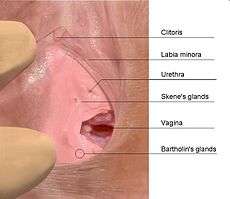Pelvic examination
| Pelvic examination | |
|---|---|
| Intervention | |
 Line drawing showing palpation in pelvic exam. | |
| ICD-9-CM | 89.26 |
A pelvic examination, also known as a pelvic exam or vaginal exam, is a physical examination of the female pelvic organs. Broadly, it can be divided into the external examination and internal examination.[1] It is also called "Bimanual Exam" (i.e. using two hands) & "Manual Uterine Palpation" (palpation meaning an examination by touch). It is frequently used in gynecology.
External examination
- examination of anatomy
- skin lesion
- palpation of stomach area
Internal examination
Speculum exam

Use of a speculum[2] to locate the external cervical os. Examination for foreign bodies and cervical swabs are taken at this point in the exam. These swabs of the epithelium layer of the cervix are known as a Pap smear. Other vaginal swabs can be taken at this time to test for sexually transmitted diseases.
Bimanual exam
Two fingers are inserted into the vagina until they isolate the cervix. Then the health care professional tests for cervical motion tenderness, as classically seen in pelvic inflammatory disease. The examiner presses down on the abdomen with the external hand, to locate the fundus of the uterus and the adnexal structures.
Discomfort
The exam should not be excessively uncomfortable, but a woman with a vaginal infection or vaginismus may feel pain when the speculum is inserted. Using the smallest available speculum may help. A woman with an untreated imperforate hymen may find it impossible to be examined. During the bimanual exam, the palpating of the ovaries may be painful. The pap smear may cause some cramping as well.
Informed consent
For educational purposes, trainee doctors have performed pelvic exams on unconscious women. The subjects are those undergoing surgery for unrelated causes, and they were rarely informed the examination had occurred. This practice is forbidden in the United States, New Zealand, and the United Kingdom, which now require the patient to consent in advance. The practice still continues in Canada according to a study published in the Journal of Obstetrics and Gynecology.[3] A spokeswoman for the University of Manitoba College of Medicine claimed in 2010 that the revised 2006 guidelines of the Society of Obstetricians and Gynaecologists of Canada forbade pelvic exams without consent,[4] though the original impetus for the study of pelvic exams and consent was an incident in 2007.[3]
American guidelines
In July 2014, the American College of Physicians (ACP) issued a guideline recommending against performing this examination to screen for conditions in asymptomatic, nonpregnant, adult women. (The guideline did not consider pap smears.) The ACP said that there was no evidence of benefit in support of the examination, but there was evidence of harm, including distress and unnecessary surgery. This was a strong recommendation, based on moderate-quality evidence.[5]
The American College of Obstetricians and Gynecologists (ACOG) disagreed. While they acknowledged that a routine annual pelvic exam was not supported by scientific evidence (see Evidence-based medicine), it was supported by clinical experiences of gynecologists treating their patients. Pelvic exams are an occasion for gynecologists to recognize issues like incontinence and sexual dysfunction, and discuss patient concerns generally, ACOG said.[6]
See also
References
- ↑ "Examination of the Female Pelvis". Retrieved 2007-12-09.
- ↑ "Pelvic exam - MayoClinic.com". Retrieved 2007-12-09.
- 1 2 "Time to end pelvic exams done without consent". The Globe and Mail. Toronto. 2012-09-06. Archived from the original on 2010-01-30.
- ↑ "Women must give consent for pelvic exam: MD - Winnipeg Free Press". winnipegfreepress.com. Retrieved 2016-10-20.
- ↑ Qaseem, A; Humphrey, LL; Harris, R; Starkey, M; Denberg, TD; Clinical Guidelines Committee of the American College of, Physicians (Jul 1, 2014). "Screening pelvic examination in adult women: a clinical practice guideline from the American College of Physicians.". Annals of Internal Medicine. 161 (1): 67–72. doi:10.7326/M14-0701. PMID 24979451.[Free text]
- ↑ ACOG Practice Advisory on Annual Pelvic Examination Recommendations June 30, 2014
